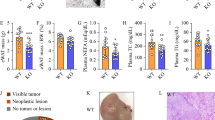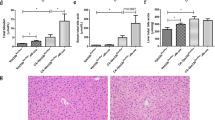Abstract
Wilson disease is caused by accumulation of Cu2+ in cells, which results in liver cirrhosis and, occasionally, anemia. Here, we show that Cu2+ triggers hepatocyte apoptosis through activation of acid sphingomyelinase (Asm) and release of ceramide. Genetic deficiency or pharmacological inhibition of Asm prevented Cu2+-induced hepatocyte apoptosis and protected rats, genetically prone to develop Wilson disease, from acute hepatocyte death, liver failure and early death. Cu2+ induced the secretion of activated Asm from leukocytes, leading to ceramide release in and phosphatidylserine exposure on erythrocytes, events also prevented by inhibition of Asm. Phosphatidylserine exposure resulted in immediate clearance of affected erythrocytes from the blood in mice. Accordingly, individuals with Wilson disease showed elevated plasma levels of Asm, and displayed a constitutive increase of ceramide- and phosphatidylserine-positive erythrocytes. Our data suggest a previously unidentified mechanism for liver cirrhosis and anemia in Wilson disease.
This is a preview of subscription content, access via your institution
Access options
Subscribe to this journal
Receive 12 print issues and online access
We are sorry, but there is no personal subscription option available for your country.
Buy this article
- Purchase on SpringerLink
- Instant access to full article PDF
Prices may be subject to local taxes which are calculated during checkout






Similar content being viewed by others
References
Zhou, B. & Gitschier, J. hCTR1: a human gene for copper uptake identified by complementation in yeast. Proc. Natl. Acad. Sci. USA 94, 7481–7486 (1997).
Klomp, L.W. et al. Identification and functional expression of HAH1, a novel human gene involved in copper homeostasis. J. Biol. Chem. 272, 9221–9226 (1997).
Lin, S.J. & Culotta, V.C. The ATX1 gene of Saccharomyces cerevisiae encodes a small metal homeostasis factor that protects cells against reactive oxygen toxicity. Proc. Natl. Acad. Sci. USA 92, 3784–3788 (1995).
Bull, P.C., Thomas, G.R., Rommens, J.M., Forbes, J.R. & Cox, D.W. The Wilson disease gene is a putative copper transporting P-type ATPase similar to the Menkes gene. Nat. Genet. 5, 327–337 (1993).
Tanzi, R.E. et al. The Wilson disease gene is a copper transporting ATPase with homology to the Menkes disease gene. Nat. Genet. 5, 344–350 (1993).
Yamaguchi, Y., Heiny, M.E. & Gitlin, J.D. Isolation and characterization of a human liver cDNA as a candidate gene for Wilson disease. Biochem. Biophys. Res. Commun. 197, 271–277 (1993).
Gitschier, J., Moffat, B., Reilly, D., Wood, W.I. & Fairbrother, W.J. Solution structure of the fourth metal-binding domain from the Menkes copper-transporting ATPase. Nat. Struct. Biol. 5, 47–54 (1998).
Payne, A.S. & Gitlin, J.D. Functional expression of the menkes disease protein reveals common biochemical mechanisms among the copper-transporting P-type ATPases. J. Biol. Chem. 273, 3765–3770 (1998).
Hung, I.H. et al. Biochemical characterization of the Wilson disease protein and functional expression in the yeast Saccharomyces cerevisiae. J. Biol. Chem. 272, 21461–21466 (1997).
Roelofsen, H. et al. Copper-induced apical trafficking of ATP7B in polarized hepatoma cells provides a mechanism for biliary copper excretion. Gastroenterology 119, 782–793 (2000).
Schaefer, M., Hopkins, R.G., Failla, M.L. & Gitlin, J.D. Hepatocyte-specific localization and copper-dependent trafficking of the Wilson's disease protein in the liver. Am. J. Physiol. 276, G639–G646 (1999).
Wilson, S. Progressive lenticular degeneration: a familial nervous disease associated with cirrhosis of the liver. Brain 34, 295–507 (1912).
Cumings, J.N. Copper and iron content of brain and liver in normal and in hepatolenticular degeneration. Brain 71, 410–415 (1948).
Gitlin, J.D. Wilson disease. Gastroenterology 125, 1868–1877 (2003).
Seth, R. et al. In vitro assessment of copper-induced toxicity in the human hepatoma line, Hep G2. Toxicol. In Vitro 18, 501–509 (2004).
Krumschnabel, G., Manzl, C., Berger, C. & Hofer, B. Oxidative stress, mitochondrial permeability transition, and cell death in Cu-exposed trout hepatocytes. Toxicol. Appl. Pharmacol. 209, 62–73 (2005).
Pourahmad, J., Ross, S. & O'Brien, P.J. Lysosomal involvement in hepatocyte cytotoxicity induced by Cu(2+) but not Cd(2+). Free Radic. Biol. Med. 30, 89–97 (2001).
Sokol, R.J. et al. Oxidant injury to hepatic mitochondria in patients with Wilson's disease and Bedlington terriers with copper toxicosis. Gastroenterology 107, 1788–1798 (1994).
Goldman, M. & Ali, M. Wilson's disease presenting as Heinz-body hemolytic anemia. CMAJ 145, 971–972 (1991).
Deiss, A., Lee, G.R. & Cartwright, G.E. Hemolytic anemia in Wilson's disease. Ann. Intern. Med. 73, 413–418 (1970).
Forman, S.J., Kumar, K.S., Redeker, A.G. & Hochstein, P. Hemolytic anemia in Wilson's disease: clinical findings and biochemical mechanisms. Am. J. Hematol. 9, 269–275 (1980).
Grassme, H. et al. CD95 signaling via ceramide-rich membrane rafts. J. Biol. Chem. 276, 20589–20596 (2001).
Cremesti, A. et al. Ceramide enables fas to cap and kill. J. Biol. Chem. 276, 23954–23961 (2001).
Dumitru, C.A. & Gulbins, E. TRAIL/DR5-induced apoptosis by the acid sphingomyelinase, ceramide and ceramide-enriched membrane platforms. Oncogene 25, 5612–5625 (2006).
Santana, P. et al. Acid sphingomyelinase-deficient human lymphoblasts and mice are defective in radiation-induced apoptosis. Cell 86, 189–199 (1996).
Rotolo, J.A. et al. Caspase-dependent and -independent activation of acid sphingomyelinase signaling. J. Biol. Chem. 280, 26425–26434 (2005).
Kashkar, H., Wiegmann, K., Yazdanpanah, B., Haubert, D. & Kronke, M. Acid sphingomyelinase is indispensable for UV light-induced Bax conformational change at the mitochondrial membrane. J. Biol. Chem. 280, 20804–20813 (2005).
Scheel-Toellner, D. et al. Reactive oxygen species limit neutrophil life span by activating death receptor signaling. Blood 104, 2557–2564 (2004).
Reinehr, R. et al. Bile salt-induced apoptosis involves NADPH oxidase isoform activation and hepatocyte shrinkage. Gastroenterology 129, 2009–2031 (2005).
Grassme, H. et al. Host defense against Pseudomonas aeruginosa requires ceramide-rich membrane rafts. Nat. Med. 9, 322–330 (2003).
Jan, J.T., Chatterjee, S. & Griffin, D.E. Sindbis virus entry into cells triggers apoptosis by activating sphingomyelinase, leading to the release of ceramide. J. Virol. 74, 6425–6432 (2000).
Petrache, I. et al. Ceramide upregulation causes pulmonary cell apoptosis and emphysema-like disease in mice. Nat. Med. 11, 491–498 (2005).
Lang, K.S. et al. Involvement of ceramide in hyperosmotic shock-induced death of erythrocytes. Cell Death Differ. 11, 231–243 (2004).
Fadok, V.A. et al. Exposure of phosphatidylserine on the surface of apoptotic lymphocytes triggers specific recognition and removal by macrophages. J. Immunol. 148, 2207–2216 (1992).
Qiu, H. et al. Activation of human acid sphingomyelinase through modification or deletion of C-terminal cysteine. J. Biol. Chem. 278, 32744–32752 (2003).
Hurwitz, R., Ferlinz, K. & Sandhoff, K. The tricyclic antidepressant desipramine causes proteolytic degradation of lysosomal sphingomyelinase in human fibroblasts. Biol. Chem. Hoppe eyler 375, 447–450 (1994).
Wu, J., Forbes, J.R., Chen, H.S. & Cox, D.W. The LEC rat has a deletion in the copper transporting ATPase gene homologous to the Wilson disease gene. Nat. Genet. 7, 541–545 (1994).
Ren, Y. & Savill, J. Apoptosis: the importance of being eaten. Cell Death Differ. 5, 563–568 (1998).
Fadok, V.A. et al. A receptor for phosphatidylserine-specific clearance of apoptotic cells. Nature 405, 85–90 (2000).
Galle, P.R. et al. Involvement of the CD95 (APO-1/Fas) receptor and ligand in liver damage. J. Exp. Med. 182, 1223–1230 (1995).
Kerr, J.F. et al. The nature of piecemeal necrosis in chronic active hepatitis. Lancet 2, 827–828 (1979).
Rouquet, N., Pages, J.C., Molina, T., Briand, P. & Joulin, V. ICE inhibitor YVAD-cmk is a potent therapeutic agent against in vivo liver apoptosis. Curr. Biol. 6, 1192–1195 (1996).
Kirschnek, S. et al. CD95-mediated apoptosis in vivo involves acid sphingomyelinase. J. Biol. Chem. 275, 27316–27323 (2000).
Paris, F. et al. Natural ceramide reverses Fas resistance of acid sphingomyelinase (−/−) hepatocytes. J. Biol. Chem. 276, 8297–8305 (2001).
Lang, P.A. et al. PGE(2) in the regulation of programmed erythrocyte death. Cell Death Differ. 12, 415–428 (2005).
Acknowledgements
The authors acknowledge the technical assistance of B. Wilker, S. Keitsch, E. Faber and W. Gfrörer and preparation of the manuscript by T. Loch and S. Moyrer. Goat antibodies to Asm were provided by K. Sandhoff (University of Bonn). This study was supported by the Deutsche Forschungsgemeinschaft (DFG) grants La 315/4-3, La 315/6-1 (to F.L.) and La 315/13-1 (to F.L. and T.W.), the Bundesministerium für Bildung, Wissenschaft, Forschung und Technologie (Center for Interdisciplinary Clinical Research) 01 KS 9602 and IZKF-Promotionskolleg “Molekulare Medizin # 1547” (to F.L., T.W., P.A.L. and D.S.K.), Wilhelm Sander-Stiftung (to T.W.), an Interne Forschungsförderung Essen grant (to M.S.) and DFG grant GU 335/10-3 (to E.G.).
Author information
Authors and Affiliations
Contributions
P.A.L., F.L. and E.G. initiated the studies. P.A.L. investigated the effects of copper on Annexin V binding to human erythrocytes and HepG2 cells. M.S. performed the rat experiments and analyzed the results. J.P.N. analyzed Annexin V binding to patient erythrocytes. J.U.B. and K.W.S. did the histology studies. D.S.K. performed ceramide measurents in HepG2 cells. A.L. performed Ca2+ measurements in HepG2 cells. S.K. and S.M.H. studied in vivo clearance of circulating erythrocytes in rats. K.E. and B.A.K. performed ceramide measurements in human erythrocytes. H.R. supervised rat experiments. K.M. measured bilirubin and amitriptyline in rat plasma. S.H. made the copper determinations. H.H., A.E. and D.H. provided blood and data from individuals with Wilson disease. T.W. supervised part of the laboratory work in Tübingen and performed statistical analysis. E.G. measured ASM activity and ceramide, did the mice experiments, analyzed the data and supervised the group in Essen. F.L. supervised the group in Tübingen. F.L. and E.G. designed the study and wrote the manuscript.
Corresponding authors
Ethics declarations
Competing interests
The authors declare no competing financial interests.
Supplementary information
Rights and permissions
About this article
Cite this article
Lang, P., Schenck, M., Nicolay, J. et al. Liver cell death and anemia in Wilson disease involve acid sphingomyelinase and ceramide. Nat Med 13, 164–170 (2007). https://doi.org/10.1038/nm1539
Received:
Accepted:
Published:
Issue Date:
DOI: https://doi.org/10.1038/nm1539
This article is cited by
-
Complex formation of pendant lysine residue-containing zwitterionic random copolymer with copper (II)
Polymer Journal (2023)
-
Myricetin-induced suicidal erythrocyte death
Molecular Biology Reports (2023)
-
The relevance of acid sphingomyelinase as a potential _target for therapeutic intervention in hepatic disorders: current scenario and anticipated trends
Archives of Toxicology (2023)
-
Association between vitamin D status and eryptosis–results from the German National Cohort Study
Annals of Hematology (2023)
-
Clinical and genetic characterization of a large cohort of patients with Wilson’s disease in China
Translational Neurodegeneration (2022)



